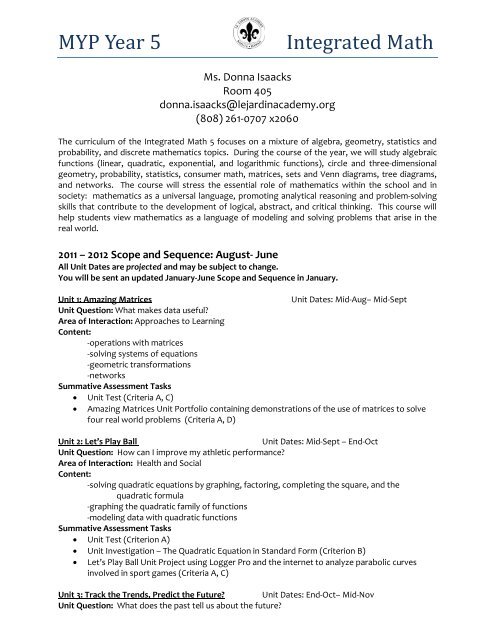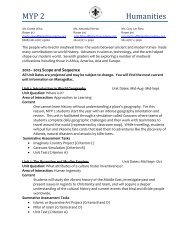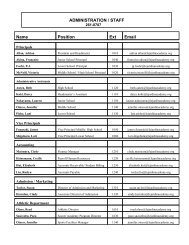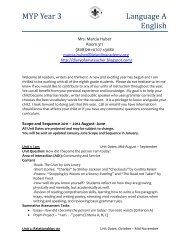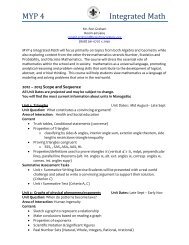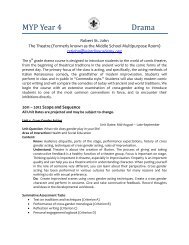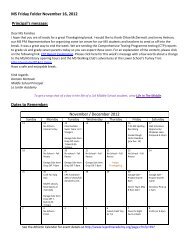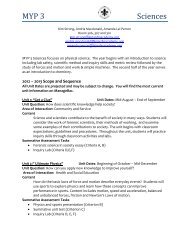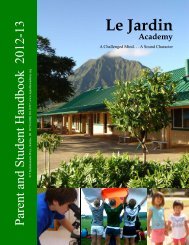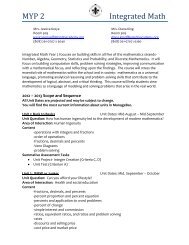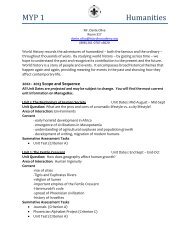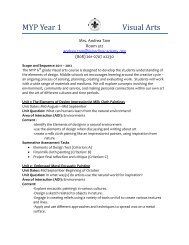MYP Year 5 Integrated Math - Le Jardin Academy
MYP Year 5 Integrated Math - Le Jardin Academy
MYP Year 5 Integrated Math - Le Jardin Academy
You also want an ePaper? Increase the reach of your titles
YUMPU automatically turns print PDFs into web optimized ePapers that Google loves.
<strong>MYP</strong> <strong>Year</strong> 5<br />
<strong>Integrated</strong> <strong>Math</strong><br />
Ms. Donna Isaacks<br />
Room 405<br />
donna.isaacks@lejardinacademy.org<br />
(808) 261-0707 x2060<br />
The curriculum of the <strong>Integrated</strong> <strong>Math</strong> 5 focuses on a mixture of algebra, geometry, statistics and<br />
probability, and discrete mathematics topics. During the course of the year, we will study algebraic<br />
functions (linear, quadratic, exponential, and logarithmic functions), circle and three-dimensional<br />
geometry, probability, statistics, consumer math, matrices, sets and Venn diagrams, tree diagrams,<br />
and networks. The course will stress the essential role of mathematics within the school and in<br />
society: mathematics as a universal language, promoting analytical reasoning and problem-solving<br />
skills that contribute to the development of logical, abstract, and critical thinking. This course will<br />
help students view mathematics as a language of modeling and solving problems that arise in the<br />
real world.<br />
2011 – 2012 Scope and Sequence: August- June<br />
All Unit Dates are projected and may be subject to change.<br />
You will be sent an updated January-June Scope and Sequence in January.<br />
Unit 1: Amazing Matrices<br />
Unit Dates: Mid-Aug– Mid-Sept<br />
Unit Question: What makes data useful?<br />
Area of Interaction: Approaches to <strong>Le</strong>arning<br />
Content:<br />
-operations with matrices<br />
-solving systems of equations<br />
-geometric transformations<br />
-networks<br />
Summative Assessment Tasks<br />
• Unit Test (Criteria A, C)<br />
• Amazing Matrices Unit Portfolio containing demonstrations of the use of matrices to solve<br />
four real world problems (Criteria A, D)<br />
Unit 2: <strong>Le</strong>t’s Play Ball<br />
Unit Dates: Mid-Sept – End-Oct<br />
Unit Question: How can I improve my athletic performance?<br />
Area of Interaction: Health and Social<br />
Content:<br />
-solving quadratic equations by graphing, factoring, completing the square, and the<br />
quadratic formula<br />
-graphing the quadratic family of functions<br />
-modeling data with quadratic functions<br />
Summative Assessment Tasks<br />
• Unit Test (Criterion A)<br />
• Unit Investigation – The Quadratic Equation in Standard Form (Criterion B)<br />
• <strong>Le</strong>t’s Play Ball Unit Project using Logger Pro and the internet to analyze parabolic curves<br />
involved in sport games (Criteria A, C)<br />
Unit 3: Track the Trends, Predict the Future? Unit Dates: End-Oct– Mid-Nov<br />
Unit Question: What does the past tell us about the future?
Area of Interaction: Health and Social<br />
Content:<br />
-identifying domain and range of relations<br />
-using function notation<br />
-graphing linear functions and interpreting the graphs<br />
-writing equations of linear functions given certain data about the graph of the<br />
function<br />
-interpreting slope, x-intercept, and y-intercept in context of a real world problem<br />
-finding an equation for the best-fitting line modeling real world data<br />
-analyzing the accuracy of the best-fitting line to predict trends<br />
-comparing linear, quadratic, and polynomial functions as models of real world data<br />
Summative Assessment Tasks<br />
• Unit Test (Criterion A)<br />
• Track the Trends, Predict the Future? Unit Project in which students choose a health or social<br />
issue of interest, gather data about this issue over time, model the data with a linear or<br />
polynomial function in order to make predictions about future trends<br />
(Criteria B, C, D)<br />
Unit 4: Geometry of Art and Architecture<br />
Unit Dates: Mid-Nov – Mid-Dec.<br />
Unit Question: How do humans construct meaning and symbolism?<br />
Area of Interaction: Human Ingenuity<br />
Content:<br />
-area and perimeter of regular polygons<br />
-circumference, arc length, and area of a sector of a circle<br />
- chords, angles, and tangents of a circle<br />
-writing geometric proofs for circle theorems<br />
Summative Assessment Tasks<br />
• Investigation (Criteria B, D)<br />
• Polygons and Circles in Architecture and the Arts (Criterion C)<br />
• Unit Test (Criteria A, C)<br />
Unit 5: Semester Examination<br />
Unit Dates: Mid-Dec<br />
Unit Question: How can I connect the knowledge, skills, and understandings from one unit of<br />
study to the next?<br />
Area of Interaction: Approaches to <strong>Le</strong>arning<br />
Content:<br />
Students will review the knowledge, skills, and understandings obtained in the first four units<br />
of the semester and apply them in a variety of situations.<br />
Summative Assessment Tasks<br />
• Unit Test (Criteria A, C)<br />
Unit 6: Working with Interest<br />
Unit Dates: January – beginning of Feb.<br />
Unit Question: How can I make healthy economic choices?<br />
Area of Interaction: Health and Social<br />
Content:<br />
-simplifying expressions using the properties of exponents<br />
-evaluating and using rational exponents<br />
-graphing exponential growth and decay functions<br />
-solving real-world problems with exponential functions<br />
-using the natural base e; evaluating logarithms<br />
-solving exponential and logarithmic equations<br />
Summative Assessment Tasks<br />
• Compound Interest Investigation (Criteria B, D)
• Test over Exponential Functions (Criterion A)<br />
• Test over Logarithmic Functions (Criterion A)<br />
• Working with Interest Project (investments and credit cards) (Criterion C)<br />
Unit 7: Packaging our World<br />
Unit Dates: Mid-Feb. (2 weeks)<br />
Unit Question: How can we make responsible choices for using our limited resources?<br />
Area of Interaction: Environments<br />
Content:<br />
- surface area of prisms and cylinders<br />
- surface area of pyramids and cones<br />
- volume of prisms and cylinders<br />
- volume of pyramids and cones<br />
-surface area and volume of spheres<br />
Summative Assessment Tasks<br />
• Unit Project – What Shape Container Should We Use? (Criteria A, D)<br />
• Unit Test (Criteria A, C)<br />
Unit 8: Analyzing Data (Statistics)<br />
Unit Dates: End-Feb– Beginning of April<br />
Unit Question: How reliable is the interpretation of data? (Can statistics ever “lie”?)<br />
Area of Interaction: Approaches to <strong>Le</strong>arning (information literacy skills)<br />
Content:<br />
-collecting and organizing data in frequency distributions and histograms<br />
-constructing and analyzing cumulative frequency histograms and ogives<br />
-calculating and using the mean and standard deviation to compare sets of data<br />
-apply the normal distribution (bell-shaped curve)<br />
Summative Assessment Tasks<br />
• Unit Test (Criterion A)<br />
• Unit Project – Designing a Statistical Study (Criteria C, D)<br />
Unit 9: What are My Chances? (Probability) Unit Dates: Mid-April – Mid May<br />
Unit Question: What are the consequences associated with the gambling industry? (Should<br />
gambling be legalized in Hawaii?)<br />
Area of Interaction: Health and Social<br />
Content:<br />
-experimental and theoretical probability<br />
-calculating the probability of mutually exclusive events<br />
-calculating the probability of combined event<br />
-using counting techniques to determine the probability of repeated events<br />
-making inferences about the distribution of data given the mean and standard<br />
deviation<br />
-calculating conditional probability<br />
Summative Assessment Tasks<br />
• Unit Test (Criterion A)<br />
• Game of Chance Project (Criteria A, C)<br />
Unit 10: End of the <strong>Year</strong> Examination<br />
Unit Dates: end of May<br />
Unit Question: How can I connect the knowledge, skills, and understandings from one unit of<br />
study to the next?<br />
Area of Interaction: Approaches to <strong>Le</strong>arning<br />
Content:<br />
Students will review the knowledge, skills, and understandings learned in the units we have<br />
studied this year and apply them in a variety of situations. Emphasis will be placed on<br />
mathematical concepts that bridge two or more units (functions, matrices, transformations,
and graphical representations of data) and on material studied second semester<br />
(exponential and logarithmic functions, solid geometry, statistics, and probability)<br />
Summative Assessment Tasks<br />
• Unit Test (Criterion A)<br />
Office hours in room 405:<br />
Students are encouraged to use office hours to receive extra learning support. These office hours<br />
may be changed due to scheduled faculty meetings, conferences, or unforeseen circumstances<br />
11:00 – 12:50 and 3:00 – 3:30 everyday


